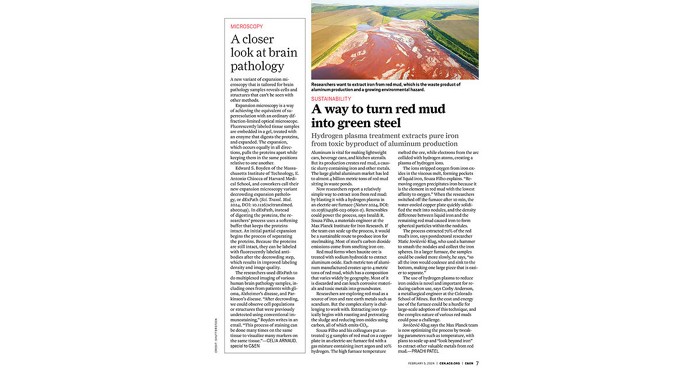Advertisement
Grab your lab coat. Let's get started
Welcome!
Welcome!
Create an account below to get 6 C&EN articles per month, receive newsletters and more - all free.
It seems this is your first time logging in online. Please enter the following information to continue.
As an ACS member you automatically get access to this site. All we need is few more details to create your reading experience.
Not you? Sign in with a different account.
Not you? Sign in with a different account.
ERROR 1
ERROR 1
ERROR 2
ERROR 2
ERROR 2
ERROR 2
ERROR 2
Password and Confirm password must match.
If you have an ACS member number, please enter it here so we can link this account to your membership. (optional)
ERROR 2
ACS values your privacy. By submitting your information, you are gaining access to C&EN and subscribing to our weekly newsletter. We use the information you provide to make your reading experience better, and we will never sell your data to third party members.
Sustainability
Producing colors with microbes gains steam
Start-ups claim biobased colors for food and textiles will benefit human health and the environment
by Matt Blois
March 9, 2023
| A version of this story appeared in
Volume 101, Issue 9

Several start-ups using fermentation to produce colors for food and textiles have raised new funding from investors. Most aim to replace petrochemical processes, arguing that their products are less harmful to human health and reduce greenhouse gas emissions.
Chromologics just raised $7.5 million to advance its red food coloring, which is made by fermentation. The product is part of a new family of fungal-derived pigments, called atrorosins, that the cofounders discovered. Chromologics says it has produced several hundred kilograms of the product and will use the funding to create new colors and advance regulatory approvals. Michroma, which raised $6.4 million in February, is also developing a fungal-derived red food coloring that it claims is healthier than synthetic food colors.
David Schoneker, a consultant who specializes in food ingredients, says consumers are worried about the health effects of artificial colors. He says those concerns are unfounded but acknowledges that they’re driving many companies to shift way from artificial colors.
The problem for food companies is that natural colors are expensive and struggle to match the stability of synthetic colors in food, Schoneker says.
Both Chromologics and Michroma say their products are stable at a wide range of temperatures and acidities. Michroma says its colors have held up through intensive processing, such as pasteurization, cooking, and extrusion.
In addition to solving technical challenges, these start-ups must clear regulatory hurdles. Schoneker says the toxicology tests required to get approval from the US Food and Drug Administration can cost between $3 million and $7 million. “It’s not something where you’re going to sell a whole lot of this in 2 years,” he says. “You have to be in it, with the right mindset, for the long haul.”
Several start-ups are also trying to replace petrochemical dyes for textiles. Last month, Pili raised $15.8 million to produce indigo using fermentation as a first step, followed by chemical conversion. Another firm, Conagen, recently scaled up fermentation-based production of a purple dye that is typically sourced from sea snails.
Pili says its manufacturing process cuts carbon emissions by 50% compared with petrochemical routes to dyes, while Conagen argues that its method is cheaper than harvesting snails.
Colorifix, which raised $22.7 million in 2022 and has plans to scale up this year, aims to slash emissions associated with the dyeing of clothes, which accounts for much of the apparel industry’s energy use. The company ferments microbes containing desired colors and uses heat to burst their membranes to deposit color on clothing fibers.
Similarly, Ever Dye aims to reduce the energy needed for the dyeing process by using plant-based dyes. The company raised $3.6 million in February.
Tiffany Hua, an analyst at Lux Research who covers the apparel industry, says textile dyes produced with microbes still cost more than synthetic options. Even with energy savings during the dyeing process, it’s not clear if apparel companies will bite, she adds. “The textile industry is very traditional,” Hua says. “They may not want to change at all.”





Join the conversation
Contact the reporter
Submit a Letter to the Editor for publication
Engage with us on Twitter